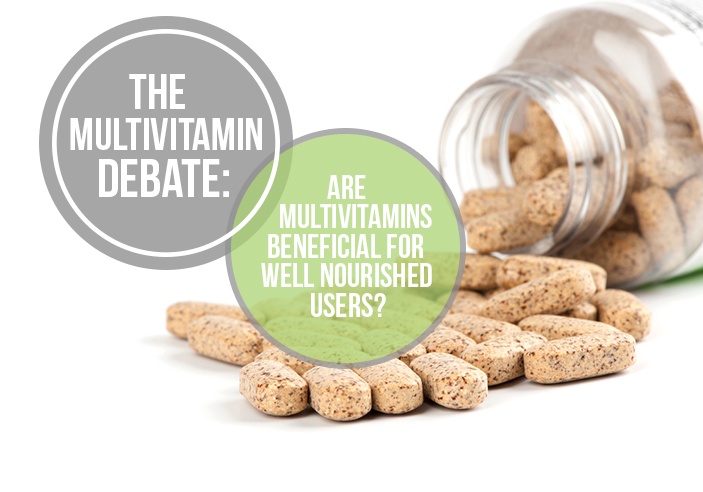For years, the debate has raged on and on about whether or not there is any real benefit to be gained by well-nourished populations from taking vitamins, particularly multivitamins.
The claim is that multivitamins do not contribute to the nutritional health of well-fed peoples, that such supplements were designed as an emergency source of nutrition for food poor groups in hard to reach locations.
But as westerners became ever more enamored by science and technology- the idea of taking food in pill form slowly became an accepted norm- whether it has any real proven value or not.
Are There Benefits To Taking Multvitamins?
Recently, an editorial published in the Annals of Internal Medicine made the final deceleration on multivitamins following a series of trials which failed to demonstrate a measurable benefit.
The authors wrote, "Enough is enough. [W]e believe the case is closed- and that supplementing the diets of well-nourished adults using (most) mineral and vitamin supplements has no obvious benefit and may even be harmful to the people taking them.”
A review published in the journal, Advances in Nutrition also examined developments in vitamin manufacturing. While it’s true that a number of studies have failed to demonstrate any clear benefits- some of them even seem to suggest that a slight risk of trauma from supplementing with specific types vitamins or minerals may exist.
There is, however, there is a missing nuance from these strong claims that is worth discussing.
The authors of these studies restate again and again that the population is nourished properly. “This is especially the case for the general population which shows no evidence of micro-nutrient deficiency, and who represent the average supplement using demographic in the U.S. and other countries.”
That reference from an NCHS Brief claims “no measurable evidence of micro-nutrient deficiency in the general vitamin-taking population in North America,” though it remains true that symptoms of micro-nutrient deficiency are uncommon in the U.S.
But, the question remains, are we really a well-nourished population?
Is America Well-Nourished?
We surveyed a portion of the U.S. population which falls short of the recommended Dietary Reference Intake (DRI) for all 21 micro-nutrients within four groups: men and women aged 19-30, and men and women over age 70.
The DRIs are agreed upon by committees in the Institute of Medicine who review studies on each nutrient in question and its relation to specific disease outcomes. If enough research material is available, an Estimated Average Requirement (EAR) will be set.
The EAR is supposed to meet the needs half the population. If an EAR is established, the Recommended Dietary Allowance (RDA) will be set, believed to cover the needs of between 97 and 98% of the total population. If and EAR cannot be established, an Adequate Intake (AI) is set instead.
In most nutrition surveys, it is clear that most Americans fall short DRIs on their intakes of many nutrients.
Using data sets assuming most people in the population took a common commercial multivitamin, most of the population achieves their recommended intakes where they did not before.
We further calculated that just 0.5% of Americans in the studied age groups reach all 21 of the recognized DRIs and that the average individual achieves 11 of them.
With such an outstanding argument for the notion that multivitamins can mitigate disease, why are the trials showing little effect?
It may help to understand what outcomes are anticipated when setting the DRIs. Here are some examples of research that has been considered when arriving at DRIs
● Vitamin E: Peroxide induced hemolysis, Parkinson's disease, LDL oxidation (cardiovascular disease), diabetes, cataracts, diabetic neuropathy, prostate cancer, immune function, Alzheimer's disease
● Folate: Vascular disease (homocysteine), anemia
● Iron: anemia, reduced work capacity, delayed psychomotor development, impaired cognition
It is worth noting that for certain nutrients, such as zinc, we don't have enough research to set DRIs based on disease endpoints, so they are derived by the rate of excretion. It may be that many relationships between diseases and specific nutrients are still not known.
Also, many nutrients are known cofactors in many enzymes that are important to a wide range of critical biological processes, which is why this idea remains plausible.
The takeaway is this: every nutrient is connected to several known disease conditions which influence their DRI.
Multivitamin Use Is Directly Connected To Reducing Diseases
Multivitamin and specific nutrient trials thus far have been focused on cancer and cardiovascular disease almost exclusively. The following are some disease endpoints limited to multivitamin studies: cardiovascular events, cognition, cancer/mortality in women, respiratory infections.
Contrary to the editorial, there are also trials that have made compelling arguments for the conclusion that multivitamins do, after all, have a range of positive effects: reduced risk of cancer in men, reduced cancer and mortality in men (not women), cancer and mortality (in undernourished populations), reduced macular degeneration, reduced cataracts in men, reduced immunity reduction risks and lower morbidity from HIV are among them.
And these outcomes don’t even break down the important variation of trial differences by primary compared to secondary prevention, issues like trial length, participant age, etc.
For example, two different epidemiological researchers claim that it takes more than 15 years of supplementation to effectively reduce the risk of colon cancer. Few clinical trials carry on for this long, and it’s impractical to do a lot of trials to test all of the plausible outcomes.
It is, of course, best to get our nutrients from food. But to provide an example, Centrum Adults costs only 7 cents per day, they are cheap and easy to take. It is also the case that the supplement industry is very difficult to regulate and there are issues and claims that go far beyond the available data. Given the high numbers of the population that still falls below recommended micro-nutrient consumption, it is premature to close the case on multivitamins.
It’s also interesting when you consider the fact that Centrum contains many synthetic vitamins which are substantively inferior to modern and naturally derived nutrients available in more modern dietary supplements.
Finally, what few to none of the clinical trials have made salient claims to are populations who are engaged in vigorous regular exercise routines- adults who tax their musculoskeletal and cardiovascular systems to extremes on a regular basis and have an elevated need for a robust supply of vitamins and nutrients. For these individuals, a good sports nutrition multivitamin is almost certainly going to have a positive benefit.







